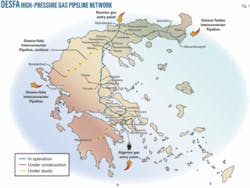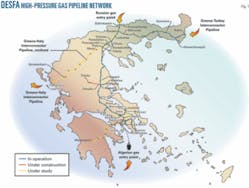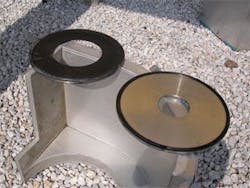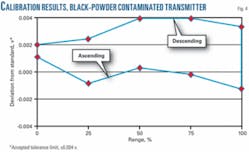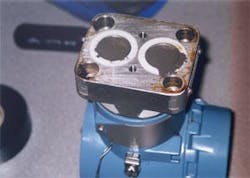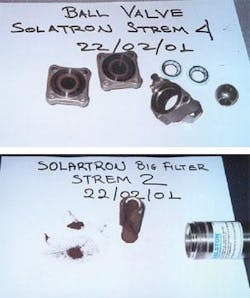Preventing black powder contamination from damaging a gas pipeline’s metering system requires regular dismantling and cleaning of its metering instruments, manifolds, impulse lines, and associated facilities. Determining which cleaning method to apply, however, requires gathering comprehensive information about the nature of the black powder problem. Only then can the operator determine which technique will provide the most efficient and cost-effective method of removing black powder from gas installations.
Background
Solid contaminantsknown as black powderfound in natural gas transmission and distribution systems are a cause of increasing concern in the global natural gas industry. Chemical or biological reactions with steel found in natural gas pipelines, gas wells, and associated facilities can create black powder. Operators can detect black powder in both dry and wet gas pipelines and in conjunction with other contaminants such as oil, grease, liquid hydrocarbons, and sand.1
Black powder influences the flow performance of gas pipelines and can also impair the function of valves and measurement systems, requiring the development of specific inspection and cleaning methods.2
The Hellenic Gas Transmission System Operator (DESFA) SA, founded in April 2007 as a wholly owned subsidiary of DEPA SA, operates, and is expanding, Greece’s national gas transmission system (Fig. 1).
The Greek gas transmission system faced its first black-powder-induced operational problems in imported Russian natural gas a few years ago.3 Pigging performed on the first 12 km of the Greek high-pressure gas network removed 1,000 kg of powder. Black powder contamination, however, continued to increase as gas off-takes grew. Powder gathering in gas piping and installations resulted in reduced flow efficiencies, clogged and collapsed filters, depositions on gas measurement devices, clogging of instrumentation, and increased deterioration of valves due to erosion.
The greatest accumulation of black powder lay in the first segment of the network, immediately downstream of the Bulgarian-Greek border, but large flow migration of the powder was documented through the mainline to various downstream lateral lines and customer delivery points.
Filtering at the entrance of processing plants or networks is the most common method of fighting contaminants. Black powder particulates, however, can shear easily to submicron sizes and pass through gas separation devices and filters, making filter-based control difficult.
Two vertical cartridge filters at the inlet of the Sidirokastro border metering station served as the primary facilities to remove black powder from Greece’s gas stream. These filters separated 100% of particles larger that 3 μm, and 99% of particles 0.5-3 μm. Black powder deposits continued to appear downstream, however, despite nearly continuous cleaning of these filters’ cartridges. Other network gas filtration devices clogged regularly and had to be replaced. The extra maintenance load on the new transmission system increased greatly workman hours, creating higher costs.
The network operator installed two cyclone (centrifugal) filtration facilities with 99% separation efficiency for contaminants larger than 5 μm at the entry point for Russian natural gas to further protect the downstream system. Operation of these cyclone separators efficiently removed the black powder.
The operator also pigged the contaminated pipelines and purged specific sections. Black powder had heavily contaminated all vented gas. Literature provides an extensive description of both the harm caused by black powder in gas pipelines and the experience gained from cleaning operations.3
Despite these efforts, however, small particles continued to flow through filtration devices, agglomerating to larger sizes downstream. Traces of black powder appeared in metering lines, fiscal metering instruments, analysers, density meters, and control valves.
This article evaluates black powder’s effect on gas metering equipment, giving guidelines for checking and cleaning instrumentation and presenting a laboratory analysis of the black powder itself.
Laboratory analysis
Samples taken from the debris of pigging operations or from filters’ deposits provided material for analysis of the powder’s chemical composition and particle-size distribution (OGJ, Mar. 12, 2007, p. 52). Black powder consists mainly of magnetite (iron oxide), a form of rust, and is highly magnetic. All other compounds found through laboratory analysis exist in common dirt. The powder contains practically no iron sulfide or other sulfur compounds.
The amorphous nature of the powder caused variance in particle-size analysis with both large particles and submicron flakes detected, though a dominant peak appeared at about 30 μm. Large particles stayed in filters and dropout vessels, while the smaller ones carried downstream and tended to agglomerate due to their magnetic properties (OGJ, Mar. 12, 2007, p. 52).
The black powder examined in this article consists of about 80% corrosion products, with the rest made up of typical soil minerals. Corrosion of upstream internal uncoated steel pipeline is the main mechanism of black powder formation,4 with gas flow introducing it into the Greek system.
Installation contamination
Small particles flowed through filtration devices despite continuous operation of cyclone and cartridge filters, prompting an investigation as to whether black powder had entered fiscal metering instrumentation and associated installations. DESFA examined all instruments and installations at its Sidirokastro border metering station (BMS).
- Orifice plates. Pressure differential devices (orifice plates) measure the gas quantity at BMS. An investigation uncovered heavy black powder deposits on the upstream face of orifice plates. The left side of Fig. 2 shows an orifice plate covered by a thick layer of black powder. This layer consists of black powder together with oil or grease, which gives the mixture adhesive properties. The right side of Fig. 2 shows a clean plate. The operator removed the dirty orifice plate from a metering line after about 1 month of operation. Both the upstream and downstream faces of the removed orifice plate showed black powder deposits.
- Metering lines. Black powder contaminated the inner metering lines, potentially affecting their roughness. Contamination may decrease pipe roughness by filling the relatively rougher underground to a smoother surface. Altering inner pipe roughness upstream of the orifice plate affects the discharge coefficient, Cd (ISO 5167), increasing the uncertainty of gas measurement5 by altering the shape of the flow profile. The unpredictable nature of this effect with time makes retroactive corrections difficult to apply.
- Impulse lines, instrument manifolds. Fig. 3 shows the arrangement of instruments on a metering line at BMS. Impulse lines feeding pressure transmitters at all metering lines contained black powder, as did the impulse lines’ primary isolation valves. Two isolation valves required changing. Enough black powder accumulated in some of the three-valve and five-valve manifolds at the fiscal pressure transmitters to cause permanent damage.
- Influence on pressure measurements. Regular monthly calibration performed to fiscal metering instruments verifies their performance. Black powder affected instrument performance. Fig. 4 shows calibration results for a representative differential pressure transmitter (Tag No. FT 20101C), with a calibration range of 0-500 millibar and a tolerance of ±0.0040 v. The instrument’s output exhibits a large hysteresis (shift) between ascending and descending applied pressures. The hysteresis recorded at the top of the calibration range (500 mbar) is particularly high (0.0046 v). These calibration results fall within the marginally acceptable range, but a clean transmitter shows negligible hysteresis in the same test.
Such metering instruments are highly likely to deviate beyond acceptable tolerance when put back in operation. When this specific pressure transmitter returned to operation, for instance, it triggered a high differential pressure (DP) deviation alarm at the corresponding flow computer.
Operators dismantled and inspected the DP transmitter, finding the manifold and associated impulse lines heavily contaminated with black powder.
Fig. 5 shows this pressure transmitter as found during inspection. Black powder almost completely blocked both the transmitters’ diaphragms.
- Water dewpoint analyzer. Contaminants clogged about 80% of the analyzer’s inlet filter, moving into the pipe beyond the filter and appearing in the sample line just before the dew point sensor. The sensor’s porous surface also likely allowed migration of the powder into it.
- Gas chromatographs. The operator detected traces of black powder at the inlet filters for sample lines of online gas chromatographs.
- Specific gravity meters. Black powder contaminated impulse lines, pressure reducers, and catch pots.
- Online densitometers. The left portion of Fig. 6 shows parts of a ball valve at the impulse line of an online densitometer. Black powder heavily contaminated the seats of this valve, filling the densitometer’s inlet pressure filters (Fig. 6, right). Black powder also contaminated the densitometer’s low-pressure internal filters, passing on to its sensitive vibrating cylinders. The operator sent the instruments to the manufacturer’s laboratories for maintenance. The manufacturer confirmed that the densitometers’ sensors were contaminated with black powder.
Corrective actions
Preventing damage to metering instruments required inspection for black powder as part of monthly inspection and calibration of fiscal instruments. These inspections repeated the findings discussed in this article; a large amount of black powder existing in instruments of all metering lines, creating the danger that impulse lines would be plugged by contaminants.
BMS operators applied a regular cleaning program to avoid abnormal operation of the instruments and reduce possible errors in gas measurement, cleaning all transmitters similar to that shown in Fig. 5 by blowing compressed air and the transmitters’ diaphragms with acetone solution.
Operators also began thoroughly cleaning all manifolds and impulse lines as part of the monthly calibration process, purging impulse lines with air and nitrogen. A special air tool also pushed pellets of cylindrical sponge into the tubes of impulse lines (Fig. 7). The white pellets turned black after just one pass through an impulse line.
The air driven pellet launcher can also remove contaminants from hoses, tubes, or pipes.
Acknowledgments
The author acknowledges helpful discussions with personnel from DESFA’s Operational & Maintenance Department in preparing this article.
References
- Baldwin, R.M., “Black Powder in the Gas industrysources, characteristics and treatment,” Technical Assessment Report No. TA 97-4, Gas Machinery Research Council, May 1998.
- Lindner, H., “A new cleaning approach for black powder removal,” Pigging Products and Services Association, (http://www.ppsa-online.com/papers/2006-Aberdeen-8-Lindner.pdf), 2006.
- Tsochatzidis, N.A., and Maroulis, K.E., “Black powder removal from gas. Evaluation of methods based on DEPA’s experience,” Pipeline Rehabilitation and Maintenance Conference, Istanbul, Sept. 14-17, 2006.
- Sherik, A.M., “Black powder in sales gas transmission pipelines,” Saudi Aramco Journal of Technology, Fall 2007, pp. 2-10.
- Reader-Harris, M.J., Sattary, J.A., and Spearman, E.P., “The orifice plate discharge coefficient equationfurther work,” Flow Measurement and Instrumentation, Vol. 6, 1995, pp. 101-114.
Based on presentation to the Pipeline Rehabilitation & Maintenance conference, Manama, Bahrain, Dec. 11-13, 2007.
The author
Nikolaos A. Tsochatzidis ([email protected]) is manager of Sidirokastro Border Metering Station at Hellenic Gas Transmission System Operator (DESFA) SA. He has 12 years’ experience in operation and maintenance of gas transmission and measurement systems, and in execution of gas purchase contracts. He is also a part-time professor of fluid mechanics at Technological College of Serres, Greece. Previously, he was researcher at Chemical Process Engineering Research Institute, Thessaloniki, Greece, and at Ecole Nationale Superieure d’Ingenieurs de Genie Chimique, Toulouse, France. He holds a PhD (1994) and a diploma (1989) in chemical engineering from Aristotle University of Thessaloniki, Greece, and also a diploma (2004) in management from Chartered Management Institute, UK. Tsochatzidis is an active member of the Technical Chamber of Greece (TEE) and other professional engineering and management societies.
